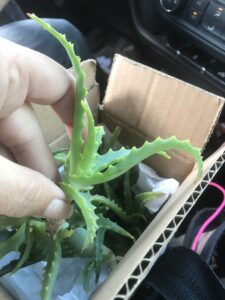S & J Nursery’s Guide to Growing
Tree Aloe / Torch Aloe / Krantz Aloe / Candelabra Aloe
in the Northeast Florida Landscape
( Aloe arborescens )
Aloe Arborescens Tree Aloe / Torch Aloe  Origins:
Origins:
The South African native aloe arborescens seems to be grown under a myriad of common names depending on your location, although not a common site here in Northeast Florida garden centers you may most probably find it here growing under the name Tree Aloe, while in
California, it seems to be referred to as torch Aloe more frequently. In its native range it is referred to as Krantz aloe. Whatever name you choose to call it, Aloe arborescens makes a great addition to the Northeast Florida Landscape. Hardy down to the mid 20’s and quite tolerant of non-irrigated spaces it is an easy care landscape plant for those of us who want something a little different in the garden. It’s shrub-like appearance and coral red flower spikes in the cooler winter months make it a decorative plant when everything else seems to be shutting down for a winter break, Aloe arborescens is just getting started with it’s annual bloom show.
Modern day herbalists tout the potency of Aloe arborescens for medicinal purposes and it seems that the scientific data backs them up. Aloe arborescens seems to show a significantly higher mineral content than the much more widely known and used True Aloe plant (Aloe Vera) / Aloe
barbadensis. Click here to open a new window for more information as well as a side by side comparison of Aloe arborescens and Aloe barbadensis. For me, this was why I first tracked down the plant for my back yard edible landscape. I found that it’s unique tree like growth and not so ground hugging habit a welcome change in the succulent garden, not to mention the pretty blooms and easy maintenance make it an ideal landscape plant as well. For me every Florida garden should have an aloe, and
why not more than one kind?
Sun Exposure of Aloe arborescens / Tree Aloe:
– Plant Aloe arborescens in a full sun to a partially shaded location in
the Northeast Florida | Jacksonville | St. Augustine area landscape.
Foliage / Growth Habit and Height of the Aloe arborescens plant:
– Torch aloe grows up and branches out eventually if left unpruned
back can grow into a 6-8 foot high and wide bush. I must admit, here in Northeast Florida, mine seem to topple in hurricane force winds, so I may never see that happen! Bright green foliage is an attractive landscape
addition.
Soil Preference / Salt tolerance of Torch Aloe arborescens:
– Drought tolerant once established into the landscape, Tree Aloe plants make great xeroscape plant and can be planted straight into Florida’s sandy soil without worry of amending the soil to hold water or nutrient.
– Avoid planting Aloe into areas of the landscape that hold water after our
frequent rains. If you don’t have the best drainage, consider planting your Aloe into a raised berm where the roots will be up out of the wet zone during the rainier times of the year. You can also use them as a container
planting and keep them in a decorative pot in the garden.
– Aloe plants make a great choice for the coastal areas of our
Northeast Florida landscapes.
Blooms of the Tree Aloe plant:
– Butterfly and hummingbird attracting, winter flower spikes rise high above the foliage and are a beautiful coral orange color.
Water Requirements:
– Although much more durable once established in the landscape, regular water is necessary to get the plant rooted and growing on its own after being planted in the ground from an S & J Tree Farm and Nursery container. Water once to twice a week for the first few weeks after planting.
Care of Torch Aloe / Tree Aloe / Krantz Aloe in the Northeast Florida / Jacksonville and St. Augustine area garden:
– Low care landscape pant selection.
– Water once to twice a week during the establishment period after planting in the garden from an S & J Tree Farm and Nursery container.
– Aloe plants will prefer areas with excellent drainage, avoid water logged
soils or areas that drain slowly after a rain.
– Fertilize each spring with a shovel full of good garden compost or a slow
release poly coated plant food such as Osmocote or Stay Green general
purpose plant food or 10-10-10.

